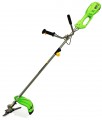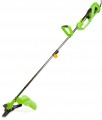Cutting width
The capture width provided by the unit, in other words, the width of the strip of land cultivated in one pass. In fact, this size corresponds to the width of the working nozzle.
The large working width is useful when processing large open spaces, as it allows you to finish the job in a small number of passes. On the other hand, for hard-to-reach places, relatively narrow tools are better suited, able to go where a wider unit will not fit. In addition, the width of the tool directly affects the weight and price.
In general, it makes sense to compare in terms of working width only units of the same type (see above). However, it is worth noting here that trimmers do not differ so much from each other — most models capture from 25 to 45 cm (and a wide processing band is provided by moving the nozzle from side to side). As for the other types, in the most modest models the capture width
does not exceed 40 cm, in the heaviest and most powerful it can be
56 – 60 cm or even
more(in mini tractors — up to 1.5 m).
Trimmer blade width
The width (diameter) of the trimmer knife characterizes the size of the paddle knife (or saw blade). Such a nozzle has a smaller capture width than a fishing line, however, it allows you to mow more dense thickets, including shrubs.
Handle type
The type of handle provided in the design of the trimmer or combisystem (see "Type").
The choice for this parameter depends primarily on the personal preferences of the user, however, there are also quite objective differences between different types. The types themselves can be:
—
Bicycle. A handle in the form of a pair of characteristic "horns" on either side of the trimmer bar, reminiscent, in accordance with the name, of a bicycle handlebar. This design allows you to comfortably mow the grass and perform other similar work; it is good in that the user's hands are in the most natural position when holding the tool. In addition, we note that the handles are convenient for both right-handers and left-handers. The disadvantage of models with bicycle handles is the relatively large weight and dimensions, as well as poor suitability for cutting branches and other work "at height". However, in the case of trimmers, such a need arises extremely rarely (especially since there are specialized varieties of garden tools for this — brush cutters and pole saws). Therefore, it is this option that has received the greatest popularity in modern trimmers.
—
Loop -shaped. The handle, which looks like a characteristic loop, usually in the shape of the letter D. The role of the second handle in such a tool is usually played by the back of the bar, and the trimmer controls are also located there.
...In general, this design is considered less convenient than a bicycle one: the user has to either hold the tool with the barbell to the side, or pull one hand back strongly. On the other hand, the loop-shaped handle gives good vertical manoeuvrability and allows you to work both at ground level and much higher, and you can easily change the height of the nozzle. As a result of all this, although this option is less popular than the “bike”, it is still quite common, mainly on relatively light and low-power trimmers.Line diameter
The diameter of the fishing line supplied with the trimmer (more precisely, with a reel attachment, see "Tips").
In modern models, this parameter can be from 1 to 4 mm. At the same time, a thicker fishing line handles better with dense thickets, but it works rougher, the treated lawn is not particularly even, and for the effective operation of such a nozzle, a fairly powerful engine is needed. On the other hand, a fine line provides a clean and neat cut, but is not suitable for heavy vegetation and large stems. Thus, thick fishing line is usually equipped with powerful units designed for "launched" lawns with an abundance of thick stems. Thin, on the other hand, is found mainly in low-power electric trimmers with a lower engine location, designed for neat lawns with regularly cut grass.
We also recall that many trimmers have the ability to replace the standard reel with another one that differs in line thickness.
Motor power
Lawnmower engine power expressed in watts. This designation is used absolutely for all electric models (see "Engine type"), and it is also often found in gasoline and diesel units along with horsepower (these units are clearly related, 1 hp is about 735 watts).
In general, the more powerful the engine, the more performant the mower and the better it will cope with heavy work such as cutting thick grass, bushes, etc. On the other hand, high power has a corresponding effect on fuel / electricity consumption, as well as the weight and price of the engine. In addition, note that the power requirements depend on the type of mower itself and its engine (see above for both). For example, for most
robots, the power
does not exceed 500 W — more, taking into account specialization, is not required, besides, otherwise the devices would turn out to be too bulky and heavy. Trimmers and lawn mowers of similar power are only electric, and the power limit for power tools is
2500 – 3000 W when powered from the mains and
1500 – 2000 W for battery models. But in gasoline tools, the minimum power is about
500 – 1000 W for trimmers and
1000 – 1500 W for mowers; the maximum value can exceed
4 kW.
Detailed recommendations for choosing a lawn mower d
...epending on its type and features of the planned work can be found in special sources.Soft start
The presence of a
soft start system in the lawn mower engine.
The design features of electric motors are such that when power is applied directly, the start occurs very abruptly — both in a mechanical and electrical sense. Firstly, the engine itself spins up in a jerk, in a very short time, which increases the wear of its parts. Secondly, at the moment of start-up, there is a sharp jump in current strength, which creates significant loads on the power grid (or the batteries of the unit). The soft start system eliminates these phenomena: it limits the starting current, allowing the motor to accelerate smoothly and preventing voltage surges.
On the other hand, additional electronic circuits affect the cost, sometimes quite significantly. So there are few models with this feature nowadays, and you should pay attention to them mainly in cases where the mentioned advantages are of fundamental importance — for example, if the device is purchased for a house with weak wiring that does not tolerate voltage surges.

